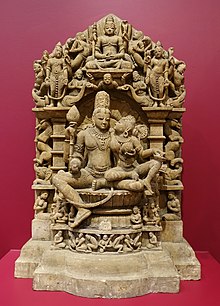Uma-Maheshwara

The Sanskrit term Uma-Maheshwara or Uma-Maheshvara (Sanskrit: उमा umā = "shine", "light"; महेश्वर maheśvara = "great lord") denotes an extremely popular constellation of the Hindu god Shiva and his wife in northern India and Nepal Uma / Parvati .
presentation
Usually the four-armed Shiva and his two-armed wife Uma / Parvati sit with one bent leg each in a tender embrace on a throne seat, below which a rocky landscape (Mount Kailash ) and / or a Nandi bull are often depicted. Shiva is often characterized by his attributes trident ( trishula ) , hourglass drum ( damaru ) or gazelle (hirana) ; the always somewhat smaller Parvati sometimes holds a mirror in her left hand, whereas the right one often hugs her “godly husband” or rests on his knee.
In the surrounding scenery there are often heavenly servants ( apsaras ) with fly whales (chamaras) or the river goddesses Ganga and Yamuna ; also small, pot-bellied musicians and dancing dwarfs ( ganas ) or ascetic followers of Shiva can appear here.
In some depictions the pair of gods is complemented by their son, the elephant-headed Ganesha .
meaning
Overall, the Uma-Maheshvara pictorial type represents an ideal and thus exemplary married couple; together with Ganesha, the three make up the "Holy Family" of Hinduism.
See also
There are no medieval depictions of Uma-Maheshvara in South India; The content and iconographically similar representations of Somaskanda dominate here .

